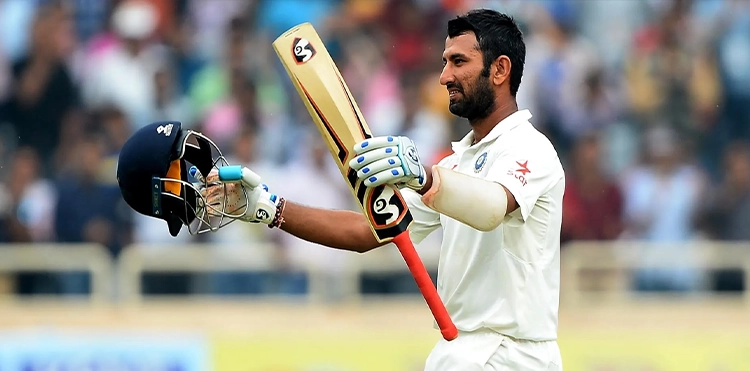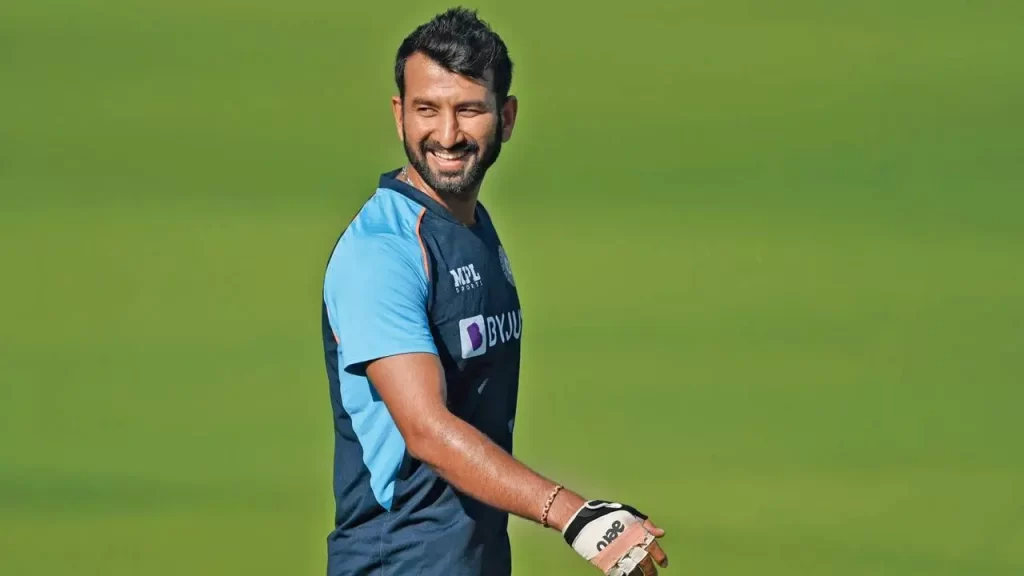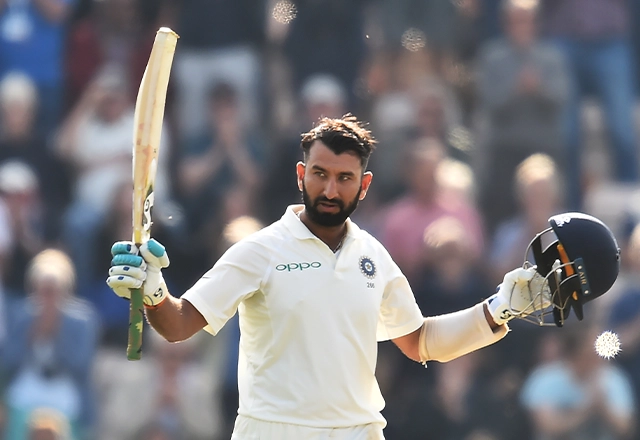In the early 2000s, there were rumors circulating in the cricketing community about a young boy from Saurashtra who had achieved a remarkable feat by scoring a triple-hundred at the Under-14 level. As time passed, more sightings of his exceptional talent emerged, including a double-hundred against England at the Under-19 level.
Personal Information
| NAME | Cheteshwar Pujara |
| Born | Jan 25, 1988 (35 years) |
| Birth Place | Rajkot, Gujarat |
| Height | 1.8M |
| Role | Batsman |
| Batting Style | Right – Handed Bat |
| Bowling Style | Right-arm legbreak |
ICC Ranking
| Role | Test | ODI | T20 |
| Batting | – | – | – |
| Bowling | – | – | – |

Career Information
| Teams | Board Presidents XI, Kolkata Knight Riders, India, Royal Challengers Bangalore, India A, Rest of India, India B, West Zone, Mumbai A, Saurashtra, Indians, Punjab Kings, Derbyshire, Yorkshire, Indian Board Presidents XI, India Blue, Nottinghamshire, Zalawad Royals, Chennai Super Kings, Sussex, Leicestershire |
Batting Career Summary
| M | INN | NO | Runs | HS | Avg | BF | SR | 100 | 200 | 50 | 4s | 6s | |
| Test | 102 | 174 | 11 | 7154 | 206 | 43.89 | 16145 | 44.31 | 19 | 3 | 35 | 856 | 16 |
| ODI | 5 | 5 | 0 | 51 | 27 | 10.2 | 130 | 39.23 | 0 | 0 | 0 | 4 | 0 |
| IPL | 30 | 22 | 3 | 390 | 51 | 20.53 | 391 | 99.74 | 0 | 0 | 1 | 50 | 4 |
Bowling Career Summary
| M | INN | B | Runs | Wkts | BBI | BBM | Econ | Avg | SR | 5W | 10W | |
| Test | 102 | 2 | 12 | 3 | 0 | 0/1 | 0/1 | 1.5 | 0.0 | 0.0 | 0 | 0 |
| ODI | 5 | – | – | – | – | – | – | – | – | – | – | – |
| IPL | 30 | – | – | – | – | – | – | – | – | – | – | – |
Career Information
| Test Debut | vs Australia at M.Chinnaswamy Stadium, Oct 09, 2010 |
| Last test | vs Australia at Narendra Modi Stadium, Mar 09, 2023 |
| ODI debut | vs Zimbabwe at Queens Sports Club, Aug 01, 2013 |
| Last ODI | vs Bangladesh at Shere Bangla National Stadium, Jun 19, 2014 |
| IPL debut | vs Deccan Chargers at Dr DY Patil Sports Academy, Mar 12, 2010 |
| Last IPL | vs Mumbai Indians at Wankhede Stadium, May 03, 2014 |
In the early 2000s, there were rumors circulating in the cricketing community about a young boy from Saurashtra who had achieved a remarkable feat by scoring a triple-hundred at the Under-14 level. As time passed, more sightings of his exceptional talent emerged, including a double-hundred against England at the Under-19 level. His reputation grew even stronger as he continued to dominate bowling attacks on his home-ground in Rajkot, to the point where officials considered changing the playing conditions due to his incredible run-making abilities at the Ranji level.

A few years later, we stumbled upon newspaper articles about the same boy, now with a more defined jawline and thicker facial hair, who went by the name of Cheteshwar Pujara. He was scoring double-hundreds for breakfast and triple-hundreds for dinner at the Ranji level. Despite being criticized for making runs on a flat Rajkot wicket for several years, Pujara began to catch the attention of selectors. In the eyes of the Indian public, he was seen as the natural successor to Rahul Dravid.
Cheteshwar Pujara’s batting style and approach are deeply rooted in tradition, which he combines with a modern mindset to great effect. His emphasis on the longer format of the game is a refreshing change in today’s world of cricket, where short-term success and lucrative franchise leagues are becoming more prevalent. While his comparison to Rahul Dravid is often made, it is more a reflection of his tenacious mindset than his technique.
He is a calm and resolute batsman whose technique relies heavily on his bottom hand, using his wrists to guide the ball rather than relying on his forearms to punch it. Despite this unorthodox approach, he has been successful due to his straight-batted technique, which involves coming down from first slip instead of gully, and his quick reflexes. He plays the ball very close to his body and has the ability to play it late, which has helped him to succeed.
In 2010, Cheteshwar Pujara received his expected national call-up during the home series against Australia. Despite being dismissed LBW by an unplayable delivery in the first innings, he was promoted to the number 3 position in the second innings instead of his “predecessor” Rahul Dravid. On a challenging 4th innings run-chase on a dry and turning wicket in Bangalore, Cheteshwar Pujara played a fluent innings of 72, becoming the fifth Indian to score a 4th innings half-century on debut.
Cheteshwar Pujara was then selected for the South Africa tour of 2010/11 and played in the 2nd and 3rd Tests, where he demonstrated his determination to stay out there with the senior batsmen. Although he didn’t make any significant contributions, he showed improvement in the second Test by standing up tall to play Morkel and opening up his stance. Unfortunately, a knee injury during the 2011 IPL prevented him from being considered for the Australia and England tours later that year.
After making a full recovery, he returned to the game during the following home season. He quickly proved his worth by scoring a fluent 206* against England in the Ahmedabad Test, and then a 135 in the Mumbai Test. Despite the other batsmen struggling to play spin, Cheteshwar Pujara fought a lone battle and showcased his skills. This marked a turning point for Cheteshwar Pujara in Test cricket, a format that he appeared to be destined for.
Pujara’s ability to dominate any bowling attack at home persisted, as he scored yet another “Daddy hundred” with a score of 204 against Australia in Hyderabad. In the Delhi Test, he opened the innings and played a crucial role in a successful run-chase, scoring an impressive unbeaten 82 in the fourth innings. Despite his partners struggling around him, Pujara seemed to be batting on a different level altogether. His efforts helped India secure a 4-0 whitewash against Australia at home.
Although Cheteshwar Pujara had achieved remarkable feats on his home turf, he was not considered a versatile cricketer due to the lack of ‘away’ runs to his name. However, he proved his critics wrong by displaying unwavering resistance on a seaming track and scoring an impressive 153 in the first Test at the Wanderers against South Africa.
Cheteshwar Pujara followed it up with a fifty in the next Durban Test, facing a formidable attack consisting of Dale Steyn, Morne Morkel, and Vernon Philander, which confirmed that he was not a one-Test wonder. Although he couldn’t replicate his score on the tour to New Zealand in 2014, he continued to exhibit remarkable grit and focus against some high-quality fast bowling, and consistently blunted out the new ball as per his role.
Cheteshwar Pujara faced a tough challenge in filling the shoes of Rahul Dravid. However, despite his ability to play out the new and seaming ball, his poor performance in England and Australia in 2014 led to him losing favor with the selectors. Despite his contribution to Ajinkya Rahane’s memorable 103 at Lord’s, Cheteshwar Pujara’s not-so-memorable 117-ball 28 on a difficult track was not enough to save his place in the Test side. Unfortunately, modern cricket is heavily influenced by statistics, and as a result, Pujara was dropped.
Despite being dropped from the Test side, Cheteshwar Pujara continued to work on his game and remained hopeful for a national comeback. His chance came in the 2015 series in Sri Lanka when Murali Vijay was injured. Cheteshwar Pujara seized the opportunity and reminded the selectors of his abilities by carrying his bat through an unbeaten 145 on a seaming wicket at the SSC, Colombo. This helped India win the decider and showcased Pujara’s mettle. Since then, he has raised the bar even further, scoring routine hundreds during India’s long home season and in series against Sri Lanka and West Indies.
Cheteshwar Pujara’s versatility was not limited to Test cricket, as he also excelled in limited overs formats. In the 2006 Under-19 World Cup, he scored an impressive 346 runs at an average of 116, ending up as the highest run-getter.
He signed with the Kolkata Knight Riders in the Indian Premier League in 2008 and later moved to Royal Challengers Bangalore for the 2011 season. However, despite his success in the U-19 World Cup, he struggled to perform consistently in white-ball cricket and was not given an extended run in the Indian ODI team. Despite this setback, Pujara remained focused on his forte – Test cricket. He even had a stint in the county circuit to improve his technique against the Dukes ball in England’s seaming conditions.
Cheteshwar Pujara is a modern rebel in the sense that he is a cricketing purist. His technique may not be the prettiest, but the charm of his batting lies in the nostalgia of the years gone by. He has a survival instinct and a home-made technique that contains all the essentials of batting, done his own way under the watchful eye of his father Arvind Cheteshwar Pujara. Despite facing ridicule for scoring gigantic hundreds on Rajkot belters, Cheteshwar Pujara and his father persevered and reaped their rewards.
When Cheteshwar Pujara was dropped for the Gros Islet Test in 2016 due to his low strike-rate, Virat Kohli’s exposure and struggle against the new ball raised an alarm and reminded the dressing room about the importance of Cheteshwar Pujara. He went on to score 1140 runs in the 2017 calendar year, playing two innings less than Steven Smith who finished top of the table.
Cheteshwar Pujara’s cricketing merit has silenced all the naysayers who doubted him. He focuses on spending more time in the nets than in the gym, working on a tailor-made cricket body rather than a beach body.
As India prepares for a lengthy away season, Pujara’s role as a key player in guarding the middle-order against the new ball will be crucial for their success in overseas conditions. With a more mature head on his shoulders and a tweaked technique, it would not be surprising if he scores runs by the barrel. Cheteshwar Pujara is a humble man who puts the team first and himself later. He understands that playing Test cricket for your country means playing the circumstances, and that is what makes him an invaluable asset to the team.
Get IPL 2023 Live Score along with Points Table & Schedule Updates at IceCric.News and Follow for Live Updates – Twitter, Facebook & Instagram.




